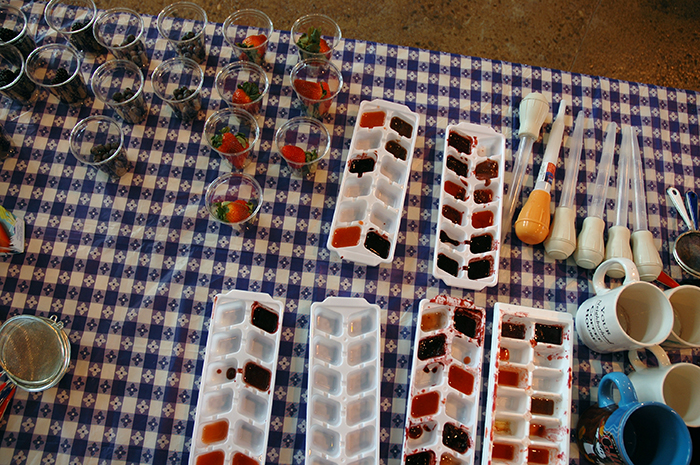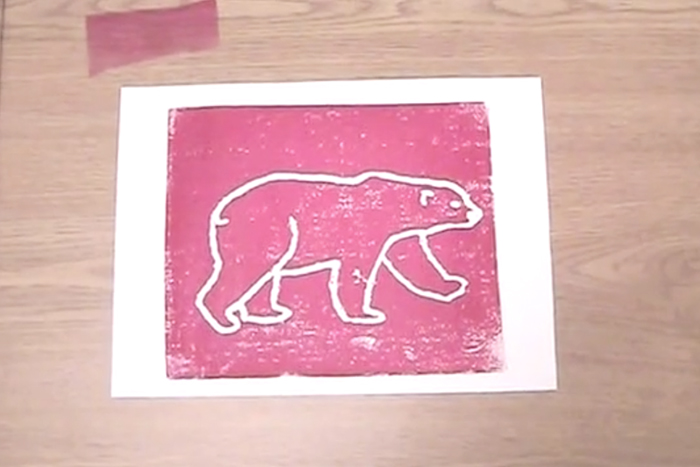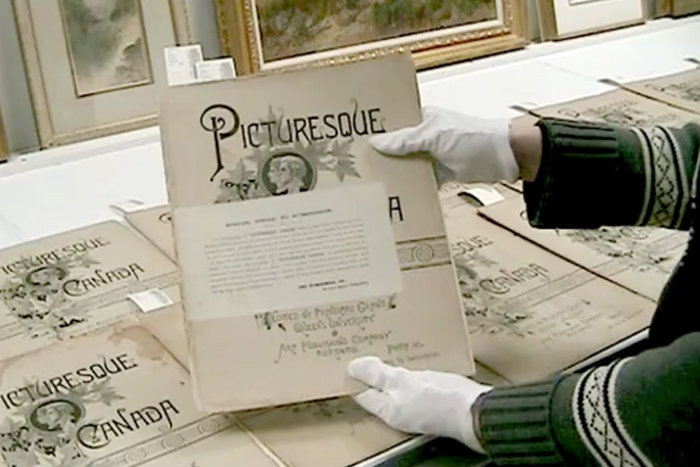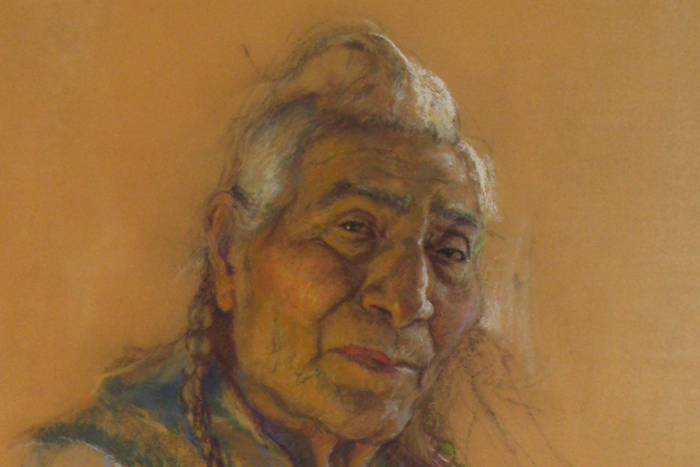Online Education Programs
Inside many art galleries are collections of art. While some institutions are lucky enough to have large buildings that publicly display these collections for the world to see on a permanent basis, most art galleries and museums have to keep their collections safely stored away and are only hung on the walls every once-in-awhile. The University of Lethbridge Art Gallery has a vast collection of paintings, drawings, sculpture and artifacts – far more than what can be put on display in the main gallery space and the Helen Christou Gallery space combined! The times these works are not on display, they are carefully tucked away and protected from the elements; similar to how someone keeps their most prized possessions in a safety deposit box.
However, one cannot ignore the fact that art is a visual communicator and we have something to learn from it. How can one learn from what is being expressed in a work of art while it is in storage? This is where the Online Education Programs and the Online Database come into the picture. Art exhibitions come and go, but these programs will be available for you to use indefinitely. Each program has links to the Alberta Curriculum in different subjects – not just in art – and has an interactive video component. Each art work is displayed in a similar fashion to a real exhibition with descriptive text panels that lead the viewer from virtual room to virtual room.
Comments and questions are always welcome! We are also available for partnerships with teachers for specific classes and learning objectives. On site gallery visits are also available. Please contact the gallery for available dates.
Email Public Programs (publicprograms uleth
uleth ca)
ca)

Aimed for all ages. Based on an ARTLab activity, how-to video and a materials list download provided.
Overall Objective:
All age groups learn how people of the past used various berries and plants to produce inks and dyes.

Aimed for Grade 2 Social Studies
Direct Objectives:
2.1.3 investigate the cultural and linguistic characteristics of an Inuit community in Canada by exploring and reflecting upon the following questions for inquiry • What are the cultural characteristics of the community? • What are the traditions and celebrations in the community that connect the people to the past and to each other? • What individuals and groups contributed to the development of the community? 2.2.7 examine how the community being studied has changed by exploring and reflecting upon the following questions for inquiry • In what ways has our community changed over time?
Overall Objectives:
2.S.1 develop skills of critical thinking and creative thinking 2.S.2 develop skills of historical thinking 2.S.8 demonstrate skills of oral, written and visual literacy.

Art, National Identity, and the CPR
Aimed for Grade 7 Social Studies
Direct Objectives: 7.2.5 evaluate the impact of Confederation and of subsequent immigration on Canada from 1867 to the First World War by exploring and reflecting upon the following questions and issues: • In what ways did the building of the Canadian Pacific Railway affect the growth of Canada? • What factors led to British Columbia’s joining Confederation?
Overall Objectives: 7.S.1 develop skills of critical thinking and creative thinking 7.S.2 develop skills of historical thinking 7.S.7 apply the research process 7.S.8 demonstrate skills of oral, written and visual literacy 7.S.9 develop skills of media literacy.

Various Activities Aimed for Grades 7, 8, & 10 The opinions expressed in the audio and video clips are those of the individuals who were interviewed and do not necessarily reflect the views of the University of Lethbridge Art Gallery.
2 – 3 Day Lesson
In this lesson, students will discuss perspectives, and how the identity of a people can be different depending on the perspective one group has toward another.
SLO’s Covered:
- 7.1.3 Compare and contrast diverse social and economic structures within the societies of Aboriginal, French and British peoples in pre-Confederation Canada by exploring and reflecting.
- 7.1.2 Appreciate the challenges of co-existence among peoples
- 7.S.1 Develop skills of critical thinking and creative thinking.
- 7.S.2 Develop skills of historical thinking.
- 7.S.8 Demonstrate skills of oral, written and visual literacy.
Instructional Objectives: Knowledge:
- Understand bias and the diversity of European social expectations towards First Nations people during colonialism.
- Understand that there can be differences in perspectives depending on culture.
- Understand how European perceptions of First Nations People led to a change in First Nations social culture.
Skill:
- Critically examine and assess primary sources.
- Use art to demonstrate bias vs. truth.
- Research and chart out understanding using primary sources.
1 – 2 Day Lesson
In this lesson, students will assess information provided in a primary audio source for clues on the culture and life of Albertan Sarcee Aboriginal Canadians. Students will explore the use of and importance of oral histories in preserving identity.
SLO’s Covered:
- 7.1.1 Appreciate the influence of diverse Aboriginal, French and British peoples on events leading to Confederation.
- 7.1.3 Compare and contrast diverse social and economic structures within the societies of Aboriginal, French and British peoples in pre-Confederation Canada by exploring and reflecting.
- 7.S.1 Develop skills of critical thinking and creative thinking.
- 7.S.2 Develop skills of historical thinking.
- 7.S.7 Apply the research process.
- 7.S.8 Demonstrate skills of oral, written and visual literacy.
Instructional Objectives: Knowledge:
- Understand the diversity found in the Sarcee people’s culture.
- Understand the value of primary sources when researching.
- Know what kinds of elements make up our cultural identity.
Skill:
- Develop questions relating to the material provided.
- Critically examine and assess primary sources.
- Brainstorm ideas.
- Articulate own perspective on the preservation of records that detail social and economic structures within societies.
1 – 2 Day Lesson
In this activity, students will assess primary sources on their ability to provide us with accurate depictions of history – especially surrounding the First Nations People of Canada and painting Nicholas de Grandmaison.
SLO’s Covered:
- 7.S.1 Develop skills of critical thinking and creative thinking.
- 7.S.2 Develop skills of historical thinking.
- 7.S.7 Apply the research process.
- 7.S.8 Demonstrate skills of oral, written and visual literacy.
Instructional Objectives: Knowledge:
- Understand the differences in language, thought and perspective between ourselves and those from history.
- Understand what a primary source is.
Skill:
- Critically examine primary sources for usefulness.
- Critically assess primary sources.
3 – 4 Day Lesson
In this lesson, students will use oral histories and sound recordings to assess the impact contrasting world views have on our understanding of history.
SLO’s Covered:
- 8.3.1 Appreciate how a society’s worldview influences the society’s choices, decisions and interactions with other societies.
- 8.3.4 Assess, critically, how the Aztecs were affected by the Spanish worldview by exploring and reflecting.
- 8.S.1 Develop skills of critical thinking and creative thinking.
- 8.S.7 Apply the research process.
Instructional Objectives: Knowledge:
- Understand the effect of education on a society’s world view.
- Understand how and why cultural contact through education can have negative consequences.
Skills:
- Articulate multiple perspectives on a given topic.
- Utilize primary resources when developing conclusions.
- Map out and validate a specific position on a topic through the use of critical thinking.
2 – 3 Day Lesson
In this lesson, students will use newspaper reports detailing historical incidents relating to Nicholas de Grandmaison’s life to identify the importance of journalism in preserving culture. Students will also identify bias and the use of art to present certain cultural beliefs and perspectives.
SLO’s covered:
- 8.1.4 Appreciate how a society’s worldview shapes individual’s citizenship and identity.
- 8.S.1 Develop skills of critical thinking and creative thinking.
- 8.S.2 Develop skills of historical thinking.
- 8.S.7 Apply the research process.
- 8.S.8 Demonstrate skills of oral, written and visual literacy.
Instructional Objectives: Knowledge:
- Understand the place bias may have in news reporting.
- Understanding how personal perspective and beliefs can shape historical ‘fact’.
- Understand how personal identity may shape people’s beliefs and actions.
Skills:
- Developing critical thinking skills through reading of primary sources and images.
- Drawing conclusions through research.
3 – 4 Day Lesson
In this lesson, students will use oral histories and sound recordings to assess the impact globalization and colonization had on the First Nations peoples of Canada.
SLO’s Covered:
- 1.4 Explore ways in which individuals and collectives express identities (traditions, language, religion, spirituality, the arts, attire, relationship to land, ideological beliefs, role modelling).
- 1.8 Analyze challenges presented by globalization to identities and cultures (assimilation, marginalization, accommodation, integration, homogenization).
- 1.9 Evaluate efforts to promote languages and cultures in a globalizing world (language laws, linguistic rights, cultural content legislation, cultural revitalization, linguistic revitalization).
- 2.1 Recognize and appreciate historical and contemporary consequences of European contact, historical globalization and imperialism on Aboriginal societies.
- 2.4 Recognize and appreciate the validity of oral histories.
- 2.5 Recognize and appreciate various perspectives regarding the prevalence and impacts of Eurocentrism.
- 2.6 Examine impacts of cultural contact between Indigenous and non-Indigenous peoples (exchange of goods and technologies, depopulation, influences on government and social institutions).
- 2.10 Examine imperialist policies and practices that affected Indigenous peoples (British rule in India, British and French rule in Canada, post-colonial governments in Canada).
- S.8 Demonstrate skills of oral, written and visual literacy.
Instructional Objectives: Knowledge:
- Identify how those who control educational institutions can control culture.
- Acknowledge the use of propaganda to promote one way of thinking over others.
- Understand why oral history preservation is important.
- Understand the impact residential schools had on the cultural of First Nations children in Canada.
Skill:
- Brainstorm ideas and come to informed conclusions.
- Express opinions through the use of examples.
- Map out multiple perspectives related to the use of residential schools in Canada.
- Articulate a perspective on residential schools in Canada through formal speech and writing.
1 – 2 Day Lesson In this lesson, students will investigate primary source material and make judgements on its effectiveness in helping to revitalizing culture.
SLO’s Covered:
- 1.7 Analyze opportunities presented by globalization to identities and cultures (acculturation, accommodation, cultural revitalization, affirmation of identity, integration).
- 1.8 Analyze challenges presented by globalization to identities and cultures (assimilation, marginalization, accommodation, integration, homogenization).
- 1.9 Evaluate efforts to promote languages and cultures in a globalizing world (language laws, linguistic rights, cultural content legislation, cultural revitalization, linguistic revitalization).
- S.7 Apply the research process.
- S.8 Demonstrate skills of oral, written and visual literacy.
- S.9 Develop skills of media literacy.
Instructional Objectives: Knowledge:
- Understand the complexities of attempting to protect or revitalize a culture.
- Identify their own family’s level of cultural assimilation.
- Understand the importance of protecting culture through a variety of sources.
Skill:
- Apply knowledge on cultural revitalization to analyze quotes.
- Apply the research process to primary source material.
- Defend choices and connect source material to their understanding of cultural revitalization.
- Critically connect historical events to cultural revitalization.
1 – 2 Day Lesson In this lesson, students will investigate multiple sources that address the critical question: To what extent does the protection of culture depend on the absence of globalization?
SLO’s Covered:
- 1.4 Explore ways in which individuals and collectives express identities (traditions, language, religion, spirituality, the arts, attire, relationship to land, ideological beliefs, role modelling) (I, CC, LPP)
- 1.5 Explore understandings and dimensions of globalization (political, economic, social, other contemporary examples) (PADM, ER, CC).
- 1.7 Analyze opportunities presented by globalization to identities and cultures (acculturation, accommodation, cultural revitalization, affirmation of identity, integration).
- 1.8 Analyze challenges presented by globalization to identities and cultures (assimilation, marginalization, accommodation, integration, homogenization).
- 1.9 Evaluate efforts to promote languages and cultures in a globalizing world (language laws, linguistic rights, cultural content legislation, cultural revitalization, linguistic revitalization).
- S.7 Apply the research process.
- S.8 Demonstrate skills of oral, written and visual literacy.
- S.9 Develop skills of media literacy.
Instructional Objectives: Knowledge:
- Understand the complexities of attempting to protect or revitalize a culture.
- Understand the positive and negative effect globalization has on unique cultures.
- Understand contemporary challenges and opportunities in protecting unique cultures.
- Understand the economy’s part in promoting and challenging unique cultures.
Skill:
- Connect source material to and understanding of globalization’s effect on culture.
- Debate the effects of globalization on culture.
- Use spoken accounts of history to draw conclusions.
- Assess current events for use in defending or drawing conclusions.